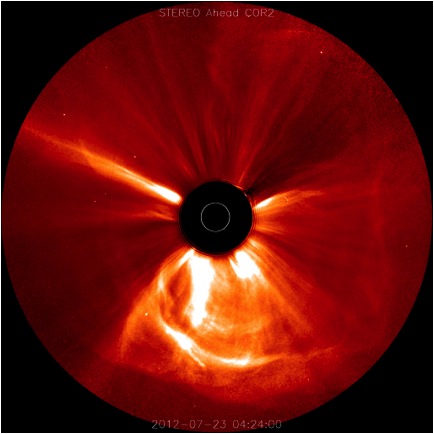The "Perfect" Solar Storm?

On July 22, 2012, a massive cloud of solar material erupted off the sun's right side, zooming out into space and passing one of NASA's two Solar Terrestrial Observatory (STEREO) spacecraft along the way. Scientists clocked this giant cloud, known as a coronal mass ejection, or CME, as traveling over 3000 kilometers per second as it left the Sun.
Conversations began to buzz and the emails to fly: this was the fastest CME ever observed by STEREO, which since its launch in 2006 has helped make CME speed measurements much more precise. Measuring a CME at this speed, traveling in a direction safely away from Earth, represented a fantastic opportunity for researchers studying the sun's effects. Now, a paper in Nature Communications, published on March 18, 2014, describes how a combination of events worked together to create these incredible speeds.
Dr. Ying Liu of the Chinese Academy of Sciences' State Key Laboratory of Space Weather and coauthors from the US (including two STEREO Principal Investigator teams), Austria, Finland, and France believe this extreme event was due to the interaction of two CMEs separated by only 10 to 15 minutes. The resulting interplanetary CME's remarkable speed may be due to its traveling through a region that had been cleared out by another CME four days earlier.
The researchers describe the July 2012 event as a "perfect storm," referring to the phrase originally coined by Sebastian Junger for the October 1991 Atlantic Ocean storm to describe an event where a rare combination of circumstances can drastically aggravate a situation.
Such work helps scientists understand how extreme solar events form and what their effects might be if aimed toward Earth. At Earth, the harshest space weather can have strong effects on the magnetic system surrounding the planet, which in turn can effect satellites and interrupt GPS and radio communications. At its worst, rapidly changing magnetic field lines around Earth can induce electric surges in the power utility grids on the ground. One of the best ways to protect against such problems, and learn to predict the onset of one of these storms, is to make computer models based on data gleaned from past events.
In the case of the July, 2012 event, three spacecraft obtained data on the CMEs: the two STEREO spacecraft and the joint NASA/European Space Agency Solar and Heliospheric Observatory, or SOHO. SOHO lies between Earth and the Sun, while the two STEREO spacecraft have orbits that for most of their journey give views of the sun that cannot be had from Earth. Each spacecraft observed the CMEs from a different angle, and together they could help map out a three-dimensional image of what happened.
The authors suggest it was the successive, one-two punch of the CMEs that was the key to the high speeds of the event - speeds that would lead to circling Earth five times in one minute. A CME from four days earlier had an impact too. First, it swept aside particles in the way, making it all the easier for the next CMEs to travel. Second, it altered the normal spiral of the magnetic fields around the sun to a straighter pattern that also allowed for freer movement.
As Dr. Liu describes this work, a key finding is that it's not just the initial conditions on the Sun that can produce an extreme space weather storm. The interactions between successive coronal mass ejections further out in interplanetary space need to be considered as well.
The researchers found that state-of-the-art models that didn't take the effects of successive CMEs into consideration failed to simulate the July 2012 event correctly. Such information needs to be incorporated in future models, and should lead to better predictions of the worst storms, which will lead to better protection of Earth and our technology in space.
Caption: Scientists studied this unusually fast coronal mass ejection Ð shown here in a movie from NASA's STEREO-A from July 22, 2012, at 10:00 p.m. EDT until 2 a.m. on July 23 Ð to improve models of extreme space weather. Because the CME headed toward STEREO-A, it appears like a giant halo around the sun. Credit: NASA/STEREO
Related links: